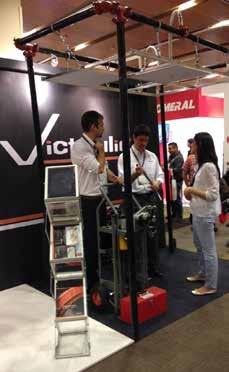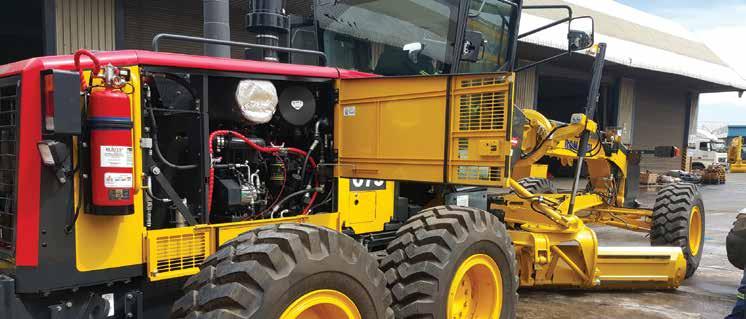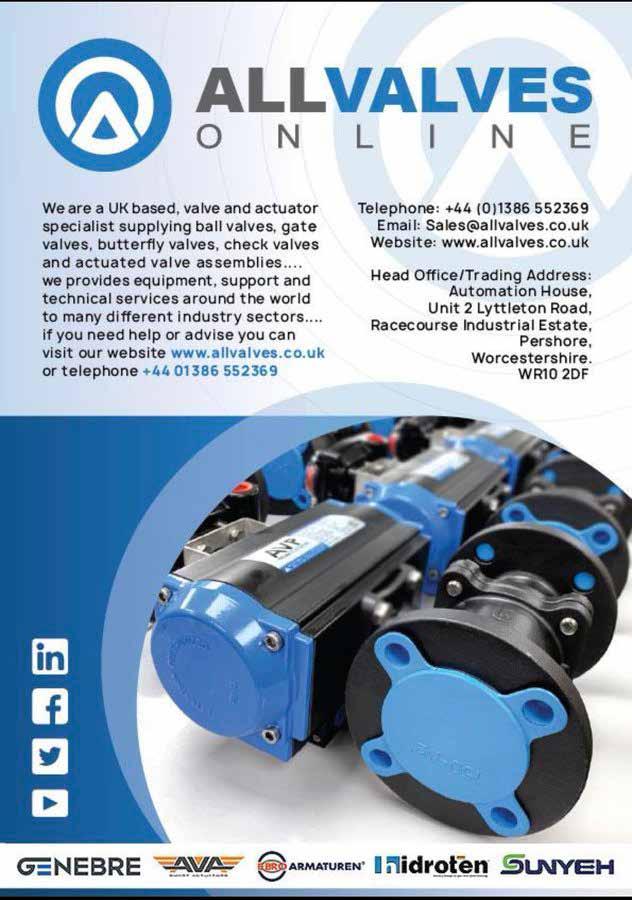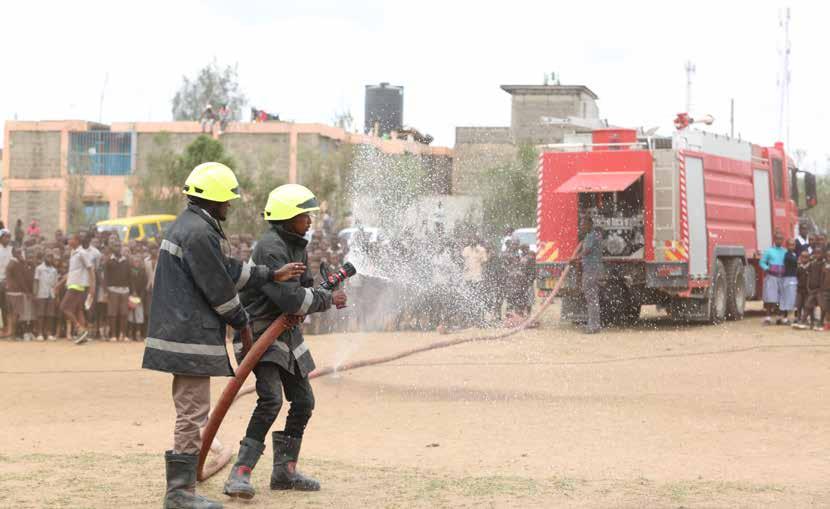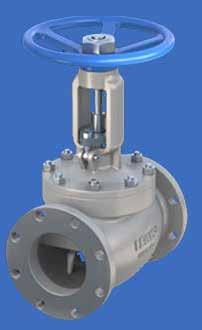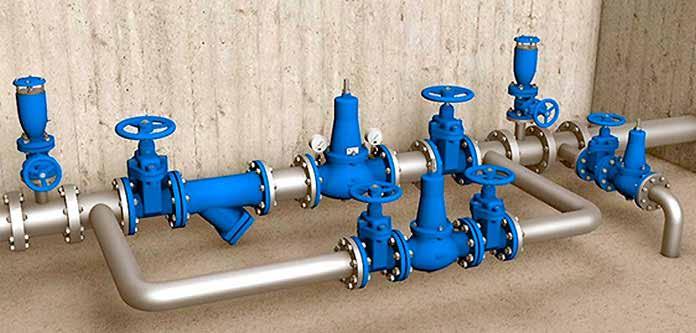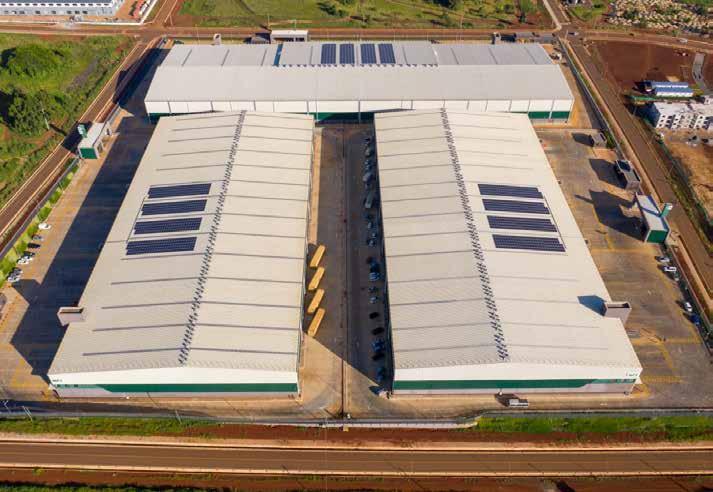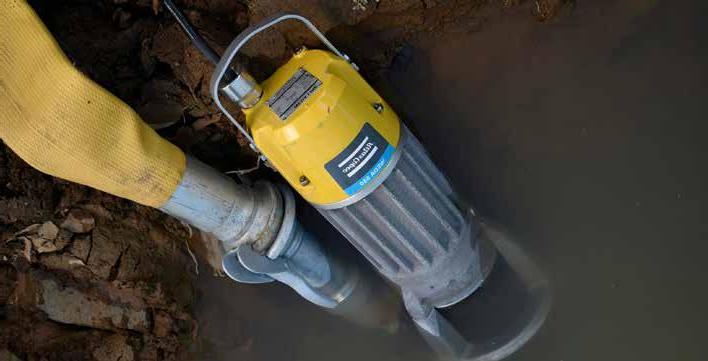
17 minute read
Could forests in African tropics be burning more than Brazil?
When the wildfire engulfed part of the Amazon rainforest in Brazil, a global outcry ensued. But new data now shows forests in the African tropics also catch fire
When it comes to wildfires, the spotlight has been on Amazon forest or Australia which recently experienced massive bushfires. But data released by NASA this week shifts the attention to Sub-Saharan Africa.
Advertisement
According to NASA’s satellite images, the size of the forest fires in central Africa appears alarmingly large. It looks like a red chain, with fires extending from Angola across Congo and Mozambique to Madagascar, similar to the flames in Brazil’s Amazon that have triggered global outcry. The NASA satellite is said to have detected 6902 fires in Angola and 3395 in Congo. However, in Brazil, 2127 fires were detected during the same period. According to this, Brazil ranked only third according to the current number of fires, said US media company Bloomberg.
But to some, fire is an essential part of the savannah.
“The first thing to know is that the impact of a wildfire depends more on where and what it is burning, than on how big it is, or indeed how many fires there are,” says ecologist Colin Beale.
Moreover, he says, fires are usually lit by cattle farmers as part of their traditional management of the savannahs where their animals graze. Some fires are started to stimulate new growth of nutritious grass for their animals, others are used to control the numbers of parasitic ticks or manage the growth of thorny scrub.
Mr. Colins makes a key observation, that around half of the grasslands of the Serengeti
in Tanzania known worldwide for its safari animals and wildebeest migration burn each year. His sentiments are shared by Angolan minister for environment Paula Francisca Coelho.
“What is currently happening in Angola are small slash-and-burn operations, mostly on arable land. These are traditionally carried out by the rural population to prepare the fields for the next season,” said Coelho.
Carbon emissions But African wildfires regardless of size come with a costly phenomenon-Carbon emission. The explanation to this issue depends on who you ask. In 2016, authors of a science journal Nature Communications said that Africa’s tropical land released close to 6bn tonnes of CO2.
The emissions were blamed on substantial land-use change including deforestation and fires associated with agriculture. The journal also blamed “strong” El Niño as the major contributor of carbon emissions. El Niño is a natural phenomenon that periodically affects weather in many parts of the world. In the African tropics, it can cause unusually high temperatures and drought.
To others fires are a natural cycle in the Savannah because much of the vegetation that burns in the dry season grows back in the rainy one, he said.
“It’s a relatively carbon-neutral process, and it’s something that does happen every year, and in fact, what we see with the fire season is that it oscillates between northern tropical Africa and southern tropical Africa every six months or so,” says Mark Parrington a Copernicus researcher.
Nevertheless, for World leaders like president Emmanuel Macron African fires are something worth looking into just like the Amazon fire. G7 nations have pledged $20 million on the Amazon, mainly on firefighting aircraft.
One of the countries that have openly sought for help to tackle wild fires is Madagascar. Fires razed more than 1,300 hectares (3,200 acres) of forestland in Madagascar’s Ankarafantsika National Park in August and September — four times the size of New York City’s Central Park.The park, in northwestern Madagascar, is home to the country’s fast-disappearing dry deciduous forests. Less than 5 percent of the country’s original dry forests survive today. The park also includes swamp forests and riparian forests that adjoin water bodies.
Farming activities The fires have been associated with farmers who burn vegetation on arable land ahead of a planting season.
“Every year, around 120,000 hectares [297,000 acres] of forest disappear, mostly as a result of slash-and-burn farming,” Alexandre Georget, Madagascar’s environment minister, told Deutsche Welle, Germany’s international broadcaster. “If the destruction continues at this rate, Madagascar will be completely deforested in 40 years.”
The government has tried to educate farmers on the dangers of this practice with little success. Authorities are now arresting villagers burning land. The government also plans to use security forces to fight fires in parks and other protected areas in Madagascar.
“Fighting fires is one of our priorities. We are calling on everyone who can help us, especially European countries,” Georget said in the interview with Deutsche Welle published in September. “We urgently need fire-fighting aircraft because, at the moment, we are unable to react quickly and effectively to fires.”
Fire Management For Sally Archibald from Centre for African Ecology, School of Animal, Plant and Environmental Sciences, University of the Witwatersrand, Johannesburg, fire management is key in tackling frequent bushfires in Africa. “Human impacts on fire regimes accumulated slowly with the evolution of modern humans able to ignite fires and manipulate landscapes, “She says.
“Modern fire management challenges involve balancing the needs of a large rural population against national and global perspectives on the desirability of different types of fire, but this cannot happen unless the interests of all parties are equally represented, “she adds.
Sally puts human activities at the centre of most fires in Africa especially the savannah fires.
“In Africa, ignition numbers increase fairly linearly with population density as humans start living in closer proximity to each other.
Ultimately, she says, when it comes to Africa, the focus should be shifted from how much burns, to how it burns to enable management plans that are feasible, and create more common ground for decisionmaking.
But with cultural practices on farming entrenched in Africa societies coupled with inadequate skills and equipment to fight the fires when they occur, the battle of wildfires in Africa could be far from being won.
Forest fire management strategies According to Food and Agriculture Organization (FAO), the number and severity of forest fires are increasing in Africa and it is becoming more difficult to predict them. With support from the international community, countries are developing mitigation procedures for wildfires, the majority of which are caused by human activities.
But the fundamental question is how to advance and implement strategies that balance the technical aspects of fire suppression with those related to human causes. African countries need to put into practice efficient technologies and management systems for fire detection and suppression. Many others have achieved encouraging results through participatory fire management schemes or schemes that incorporate both aspects.
FAO’s checklist for participatory fire management activities suggests, among others, the supply of necessary firefighting tools to the local fire units and training the local fire units in prescribed burning.
Ruhrpumpen Fire Systems
Fire pumps play a vital role as the first response to a fire situation, saving countless lives and property from destruction. They are usually found in manufacturing and industrial facilities, housing complexes, power plants, schools, hospitals, airports, commercial buildings and offshore oil platforms.
A fire pump is the component responsible for supplying the adequate water pressure to fire sprinklers and hose standpipes in order to control or contain a fire. Ruhrpumpen’s centrifugal pumps combine the latest in hydraulic design with decades of application experience to meet today’s fire security requirements.
Per NFPA-20, we are able to supply ranges from 25 GPM up to 5000 GPM with net pressures of 40 PSI or more. Our fire pumps are available as single pumping units or complete pre-packaged fire systems (with or without full enclosure).
Single source responsibility and service

The combination of our engineering team, ISO 9001 manufacturing team, outstanding design, and quality construction, all ensure Ruhrpumpen’s fire pumps and systems have strong reliability in case of an emergency. Ruhrpumpen’s Global Service Network provides all forms of field services (start-up support, inspection, maintenance, and much more) no matter where your site is located.
Time and space saving
Our cost-effective packaged fire systems save you time and space as they can be dimensioned to precisely fit the specified area facilitating its installation. The system is delivered on a single shipment, leaving only pipe and power connections to be completed on site.
Fully customizable
In order to match the specific requirements of any application, our engineering team can design complete pre-packaged fire pump systems that can vary from a fire pump with an electric driver on a skid, to a fully prefabricated unit with environmental enclosures. 26
Ruhrpumpen is your single source supplier
■ Original Equipment ■ Spare parts ■ Installation and startup support ■ Repair and maintenance ■ Engineering, training and consulting
Benefits of our pumps:
■ Proven reliability ■ High efficiency designs ensure lowest operating cost ■ Robust design allows for long system life with minimal maintenance ■ Optimized total cost of ownership
Before it’s painted red...

Nothing is left to chance with a Ruhrpumpen fire pump system. It is completely built, tested and certified in our facility, ensuring that the stringent requirements of of governing bodies such as the National Fire Protection Association (NFPA), Factory Mutual (FM), Underwriter’s Laboratories (UL) and Electrical Testing Laboratories (ETL) are met. As per NFPA-20, each pump is tested at our manufacturing facilities to provide detailed performance data and to demonstrate its compliance with the required specifications.
During the manufacturing and assembly processes, each pump goes through meticulous production controls, inspections and tests. We inspect all fire suppression equipment through advanced testing techniques and precise calibration instruments that enable us to guarantee that their operation complies with the required standards. ■ Calculations for bearing life, bolt stress, shaft deflection and shear stress must be submitted and approved by
UL & FM. ■ Casing hydrostatically tested – two times rated maximum working pressure. ■ Performance testing witnessed by UL & FM representatives. ■ Quarterly follow-up audits of product and facilities is conducted by both UL & FM. ■ Drawings of any component on the Primary Materials list must be approved before any change transpires.

Ruhrpumpen Fire Pumps: the heart of your fire protection system
Construction materials
Our fire pump components such as casing, impeller, shaft and bowls, are available in standard and special metallurgies to address specific applications.
Standard materials include: ■ Cast iron ■ Ductile iron ■ Carbon steel Metallurgies available for sea/ brackish water applications and harsh environments: ■ Stainless steel ■ Duplex ■ Super Duplex ■ Nickel-Aluminum-Bronze
Split case fire pump
Horizontal, single and two stage, split case centrifugal pumps
Characteristics
Benefits
■ Ease of installation and maintenance ■ Wide range of applications ■ Construction materials for seawater service are available
End suction fire pump
Horizontal, single stage, end suction centrifugal pumps
Characteristics
Benefits
■ Back pull-out design simplifies maintenance and reduces problems associated with pipe strain
Vertical turbine fire pump
Vertical, single and multi-stage, turbine pumps
Characteristics
■ Flows from 250 to 5000 GPM ■ Pressures from 40 to 519 + PSI ■ No priming ■ Adaptability to water level ■ Electric or Diesel driven ■ UL-448 listed ■ FM-1312 approved ■ NFPA-20 design ■ Factory tested
Benefits
■ UL listed and FM approved pump for suction lift conditions ■ Minimal maintenance ■ Can be used where city water is not available and ponds or lakes are the only water supply ■ Construction materials for seawater service are available
In-line fire pump
Vertical in-line centrifugal pumps
Characteristics
■ Flows from 150 to 1000 GPM ■ Only available with electric drive ■ Pending UL Listing and FM
Approval ■ NFPA-20 design ■ Factory tested
Benefits
■ Top pull-out design simplifies maintenance ■ Compact, space-saving design
Jockey pump
Pressure maintenance jockey pumps are available as vertical multi-stage and end suction pumps
Characteristics
■ Jockey pumps are normally sized for 1% flow and a 10 to 20
PSI higher pressure of the fire pump ■ Maintains system pressure to prevent the main fire pump from starting when small leaks occur ■ Factory tested
Benefits
■ Versatility in performance and design ■ Low operating cost
Packaged Fire Pump Systems
Our fire protection pumping solutions can be found all around the world in a variety of industrial, commercial and residential applications. RP’s pre-packaged fire systems are tailored and built to the requirements of the customer ensuring that they meet international and local safety regulations.
Our pre-packaged systems accommodate any of the RP fire pump models, with drivers, control systems and pipework on a common base for a plug-and-play installation. They can be skid mounted, with or without enclosure, and supplied with electric motor or diesel engine.
1. UL-142 Double Wall Day Tank 2. UL Listed Jockey Pump Controllers 3. UL/FM Fire Pump 4. FM Flow Meter 5. Throttling Valve 6. Electric Motor 7. UL/FM Electric Control Panel 8. Jockey Pump Pre-packaged fire system, diesel driven, with split case pump

9. Tamper Switches 10. UL/FM Listed OS&Y Gate Valves 11. Copper Sensing Lines 12. Schedule 8-CPVC Containment Piping for Fuel Piping 13. UL/FM Listed Diesel Engine 14. ASTM A36 Structural Steel Skid 15. UL/FM Diesel Control Panel 16. Floor Drain System
Other (optional) features of Ruhrpumpen’s Pre-Packaged Fire Systems:
■ Our marine fire suppression systems offer high performance coating systems for corrosive or coastal environments ■ Stainless piping for seawater or brackish water applications ■ NFPA-20 compliant mobile pre-packaged fire systems are available ■ ABS certification for offshore platform fire pump packages and fire skid units ■ Leveling bolts ■ Custom alarm panels
Individual split case pump baseplate with on-skid control panel

NFPA-20 compliant Fire Pump Houses
Completely pre-assembled and fully enclosed packages for a trouble-free and quick installation
Our packaged systems can be contained on a weatherproof, non-combustible enclosure engineered and constructed per NFPA-20 and including: ■ Heating and ventilation ■ Approved or listed source of heat ■ Normal and emergency lighting ■ Drainage ■ Convenience outlet
Optional features:
■ Pre-wired and pre-piped ■ Architectural finishes ■ Pre-piped sprinkler systems for ■ Safety equipment pump house interior ■ Grating floor deck design ■ Exhaust fan ■ Seismic calculations with PE Stamps ■ Mini power zone ■ Open skid design ■ Wall or floor access for piping ■ Diamond plate floor deck design ■ Containment piping ■ UL Listed and FM Approved pumps ■ ETL listed ■ Single shipment delivery, ready for installation ■ Plug-and-play installation ■ Single source responsibililty for complete pump house ■ Factory tested ■ Engineered to customer requirements


General arrangement of a NFPA-20 compliant fire pump house.
Control Panels
When there’s an emergency, it’s better to count on a reliable fire pump controller. Ruhrpumpen can offer electric, diesel and jockey control panels; which are available for configurations with one or more drivers, and programming for fully automatic or manual operation types.
Electric and diesel control panels are UL/ULC listed and approved by FM and CSA, as well as meeting or exceeding the requirements of NFPA-20 and NFPA-70.
Electric panels Low voltage configurations include: ■ Across the line ■ Soft start ■ Delta open / closed ■ Primary resistor ■ Auto-transformer ■ Part winding
Medium voltage configuration: ■ Across the line
Diesel panels
Diesel control panels are available for 12 volt (120, 220/240 VAC) diesel fire pump engines.
Jockey panels
Single or three phase jockey fire pump panels designed for 50 & 60 Hz in a variety of voltages.

Your business’s sustainability depends on your fire protection system
facilities and distribution centres among your business assets, the installation of high-quality fire protection systems within these spaces is critical. In commercial and industrial properties, sprinklers are the number one means of preventing loss of life and protecting valuable assets and infrastructure. They have been serving this purpose for more than a century, after all. Structures without these measures in place are unlikely to survive a blaze. Of course, there are also strict rules and regulations that guide commercial fire safety in South Africa. The South African National Standard 10400 Part T provides detailed requirements for the design and construction of buildings, as well as the fire protection equipment with which they must be fitted. These requirements are designed to protect the people using the building and to offer guidance on preventing the spread and intensity of any fire that might occur. But installing these systems is a complex process that is both time and labour intensive. In the case of industrial sprinklers, for example, each sprinkler usually has to be doped and taped before it can be installed, and a sprinkler wrench is required to secure it in place. In large commercial sites, this exercise can take days to complete, and the repetitive motion of using a sprinkler wrench can be damaging for both the integrity of the sprinkler and the health of the installer.
Quick, easy and safe
“The most important aspect of any fire protection product or service is that it works properly every single time,” says Marcel Ley, Regional Manager of Victaulic South Africa. “These systems can be single-handedly responsible for keeping your business financially intact should you experience a fire, and neglecting them is not only illegal but may result in your business’s downfall.” Fortunately, Victaulic’s fire protection piping systems make this process quicker, easier and safer. Victaulic has been developing engineering solutions for the most complex piping challenges since 1919, and its grooved mechanical coupling for fire protection dates to 1952. Today, the company is the world leader in pipe joining and flow control solutions, and its range of grooved couplings, fittings, sprinklers, devices and accessories are as vast as they are state of the art. “Our extensive range is designed to cater for the specific needs of commercial and industrial applications,” explains Ley. “We understand the unique circumstances and environments in which our clients work, and tailor our solutions to ensuring that their fire protection needs are met with the most reliable equipment, and that they save time and money in the process. These interventions help to ensure our clients’ long-term business sustainability.”
A seamless installation process
An important component of Victaulic’s approach is the installation process itself. In 2005, Victaulic developed its patented Installation-Ready™ technology. which provides fast, easy pipe connections, and reduces the number of loose parts to drop or misplace. The single-unit design of our Installation-Ready couplings and fittings allows an installer to join the pipe simply by inserting them onto the grooved end of a pipe and tightening the nuts leading to big time and cost savings.
Prior to this technology, in order to install a grooved coupling, the coupling itself was completely disassembled and then

If you count warehouses, storage
reassembled onto the pipe ends. “The final product you have in your hand can be installed in no time at all,” explains Ley. “In the case of the FireLock IGS Style V9 Installation-Ready sprinklers, for example, all you need is an impact or standard pocket wrench and the provided installation bit to tighten the bolt. Do this until metal-to-metal bolt pad contact is made, closely inspect your work, remove the bulb protector, and you’re ready to move on. No need for threading the pipe and the use of consumables, like tape and dope, is taken out of the equation”
The materials used in the installation are also important. The use of a sprinkler wrench can increase the chance of leaks as installers over-torque, potentially damaging the sprinkler frame and the sprinkler itself. This motion also affects the arm and shoulder of installers, which often take strain from the repetitive motion.
The ease with which Victaulic’s fire protection products can be installed, by contrast, minimises this impact significantly. Rather than a sprinkler wrench, installers need only have a power tool in hand, which makes the process simple and absolutely safe, while greatly reducing the physical impact.
Using world-class products that are guaranteed to fulfil their intended purpose is non-negotiable when it comes to fire protection. But the work doesn’t end with their installation. “It’s equally important that these systems are regularly maintained, tested and serviced to ensure that they are functioning properly,” Ley says. “As a guide, we recommend inspecting your systems every three months. That way, you can rest assured that the sprinklers overhead are keeping your assets – and your livelihood – safe.”

